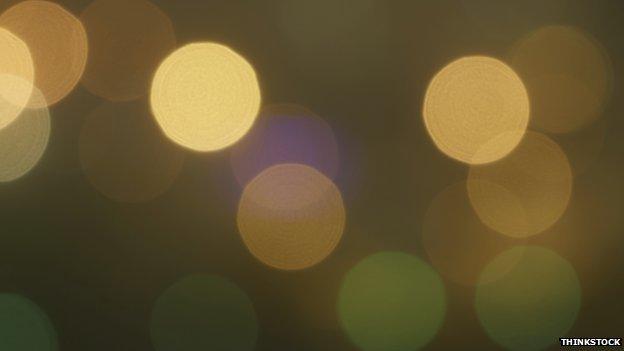What people see instead of darkness
- Published

Ouch's recent article on what a blind BBC journalist "sees" prompted lots of readers to email their own experiences.
Damon Rose completely lost his sight as a child, but his world is far from pitch black - rather, it is an ever-changing array of luminous colours and light. Consultant ophthalmologist and ophthalmic plastic surgeon Raj Das-Bhaumik, from the Moorfields Eye Hospital in London, shares his thoughts on some of our readers' responses.
David Musselwhite: "I have had perfect vision all my life until two years ago when I started to experience strange swirls of flickering vibrant diamond-shaped lines in my vision that did not go away when my eyes were closed. They were quite frightening at first. The opticians diagnosed them as 'visual migraines'. They go after about 20 minutes but they are similar to what was described in the article. I have no control over what I see and can not stop them, so I can understand what Damon is saying about his 'vision'. They are very vibrant and distracting."
Das-Bhaumik: This sounds like a classic migraine. A migraine is thought to be a temporary reduction of oxygen going to the visual cortex at the back of the brain. The blood vessels then dilate to compensate and this can cause a headache. The flickering and the shapes are very common. The other thing to remember is that migraines can have many symptoms - they can cause tummy upsets, a fear of loud noise - the visual effects are just the most obvious.
Alexander Dowding: "I'm completely blind in my left eye (since I was three). I don't see lights as Damon does - I literally don't see, from that eye. That is to say, it is like trying to see out of one's foot."
Das-Bhaumik: Blindness as we know it is a fairly subjective term, it doesn't always mean that people are totally blind and see nothing. But for some people that is the case. There are many different levels.

Anon, Australia: "I am not blind but I did have cataracts removed a couple of years ago. To remove the cataracts the lenses are shattered by a laser and then removed by suction. For a short time (about 10 minutes) you are without vision - blind, I guess. When the laser shatters the lens, you experience the most fantastic coloured light display. In my case it was a circular spinning set of triangular shapes that kept changing colour and spinning around, overlapping one another and moving out of vision. I mentioned this to the eye specialist and he said no-one had ever described it to him before. So the brain obviously does create from within when external sensory stimuli is removed."
Das-Bhaumik: I've certainly had this described to me before. If you imagine a lens to be like a Smartie, in cataract surgery we divide it into four quadrants - so essentially they become triangles - before they are taken out. We use water in the eye during the operation which constantly swirls around the eye so these triangles can float around and overlap. It sounds exactly like what he was seeing.

Mike George: "When I was a kid I used to close my eyes tight and cup my hands over them to block out all the light. After a few minutes, I started to experience moving patterns, like a paisley design in motion. The more I practised, I was eventually able to change the pattern on demand. I couldn't predict what the next pattern would be but I could shift it to something else. At first I made the mistake of trying to focus on the moving image, which did not work as I was not really 'seeing' but rather experiencing it. The less I tried to see it, the more it became illuminated."
Das-Bhaumik: We've all done this - haven't we? It's similar to when you come in from the light into a dark room and you can get some squiggly lines and fuzzy shapes. It occurs when the visual system has to readjust itself to a darker environment, effectively becoming more sensitive.

Stephanie Holdsworth: "Although I have no visual impairment (except glasses against short-sightedness) I have always been fascinated by what happens when the eyes don't see anything. I have often tried to express or explain what I see when my eyes were totally covered or when in a totally dark place (like an unlit underground cave). And Damon's description of brown background with turquoise, blue and/or green flashes with flecks of orange-yellow as well as geometrical patterns pulsating is exactly what I experience. I'm wondering if that's what the brain does to everyone when the outside stimulus is missing."

Raj Das-Bhaumik
Das-Bhaumik: I think she is right. It is the brain trying to make sense of what's going on around with limited information.
Andy Bennett: "My mum has been as you would call a 'total' [in terms of blindness] all her life. When I was young, I did try to explain certain colours. For example, for red, I would ask my mum to close her eyes and look at the sun because I knew that when I did this, the colour red would be visible - for me anyway. We were never quite sure if it had worked. As far as I know she has never had this light tinnitus [described by Damon Rose] but I wonder if this is because she has never experienced light or colour stimuli."
Das-Bhaumik: If she was completely blind she would have no perception of light, so staring at the sun shouldn't have made a difference. But, of course, in some cases you just don't know.
Eve Adkins: "I had an enucleation (removal of the entire eye, which means the optic nerve is cut as close to the brain as a surgeon dares) and I found afterwards I would get flashes of colour that corresponded to my surroundings. For example, watching the Simpsons, yellow flashes would occur. I hear water and blue flashes would appear. This can simply be explained by neurons that are still trying to go through a severed optic nerve and the brain trying to interpret accordingly."
Das-Bhaumik: This is something called synaesthesia, where you stimulate one sense and it automatically and involuntarily stimulates another. The senses are somehow coupled. You hear the Simpsons and your brain remembers the yellow, so that's what you see.

Grace Mishler, Ho Chi Minh City, Vietnam: "I am not completely blind. I have three degree residual vision. If I had a 'bright day' or have been on the computer too long, my vision at night is like being in a fog... but the fog is completely white. I dislike this 'fog' because it is hard to fall asleep because there is a haze. I find, though, if I lean my head [on the] pillow, relax myself, all of a sudden green, then black squares, like a spider web, appear. I become happy because it means my vision is trying to produce darkness. It is in this darkness I can finally fall asleep."
Das-Bhaumik: When you stimulate the retina with light, the visual pathways take time to reset when in the dark. This sounds like it is taking time to reset or adapt. Some people just take longer than others.
Terry Neal: "I was involved in an industrial accident which caused me to lose vision in my left eye. It is not dark or black - it is a blinding orange with, like the article said, fireworks sometimes so bright it scares me and I almost think I hear a bang. The bright light in the blind eye interferes with my working eye. It never goes away even with my eye closed under a patch."
Das-Bhaumik: It may be that there is still some stimulation to the eye or the optic nerve has some sensitivity to light. There may be a loss of regulation as to what is transmitted to the brain or what is perceived.
Damon Rose's experience was broadcast on BBC Radio 4's In Touch programme which airs every Tuesday night at 20:40 GMT. Listen back on the iPlayer
Follow @BBCOuch, external on Twitter and on Facebook, external, and listen to our monthly talk show